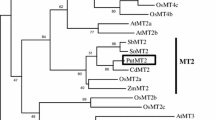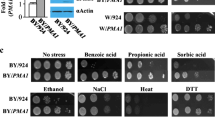Abstract
Pho84p, the protein responsible for the high-affinity uptake and transport of inorganic phosphate across the plasma membrane, is also involved in the low-affinity uptake of heavy metals in the Saccharomyces cerevisiae cells. In the present study, the effect of PHO84 overexpression upon the heavy metal accumulation by yeast cells was investigated. As PHO84 overexpression triggered the Ire1p-dependent unfolded protein response, abundant plasma membrane Pho84p could be achieved only in ire1Δ cells. Under environmental surplus, PHO84 overexpression augmented the metal accumulation by the wild type, accumulation that was exacerbated by the IRE1 deletion. The pmr1Δ cells, lacking the gene that encodes the P-type ATPase ion pump that transports Ca2+ and Mn2+ into the Golgi, hyperaccumulated Mn2+ even from normal medium when overexpressing PHO84, a phenotype which is rather restricted to metal-hyperaccumulating plants.




Similar content being viewed by others
References
Amberg DC, Burke DJ, Strathern JN (2005) Methods in yeast genetics. A Cold Spring Harbor Laboratory course manual. Cold Spring Harbor Laboratory Press, Cold Spring Harbor, pp 135–139
Antebi A, Fink GR (1992) The yeast Ca2+-ATPase homologue, PMR1, is required for normal Golgi function and localizes in a novel Golgi-like distribution. Mol Biol Cell 3:633–654
Baker AJM, Brooks RR (1989) Terrestrial higher plants which hyperaccumulate metallic elements—a review of their distribution, ecology and phytochemistry. Biorecovery 1:81–126
Baker AJM (2002) The use of tolerant plants and hyperaccumulators. In: Wong MH, Bradshaw AD (eds) Restoration and management of derelict land: modern approaches. World Scientific Publishing Co., Singapore, pp 138–148
Borst-Pauwels GW (1981) Ion transport in yeast. Biochim Biophys Acta 650:88–127
Brachmann CB, Davies A, Cost GJ, Caputo E, Li J, Hieter P, Boeke JD (1998) Designer deletion strains derived from Saccharomyces cerevisiae S288C: a useful set of strains and plasmids for PCR-mediated gene disruption and other applications. Yeast 14:115–132
Bradford MM (1976) A rapid and sensitive method for the quantitation of microgram quantities of protein utilizing the principle of protein-dye binding. Anal Biochem 72:248–254
Bun-ya M, Nishimura M, Harashima S, Oshima Y (1991) The PHO84 gene of Saccharomyces cerevisiae encodes an inorganic phosphate transporter. Mol Cell Biol 11:3229–3238
Bun-ya M, Shikata K, Nakade S, Yompakdee C, Harashima S, Oshima Y (1996) Two new genes, PHO86 and PHO87, involved in inorganic phosphate uptake in Saccharomyces cerevisiae. Curr Genet 29:344–351
Cocs JS, Walter P (1996) A novel mechanism for regulating activity of a transcription factor that controls the unfolded protein response. Cell 87:391–404
Culotta VC, Yang M, Hall MD (2005) Manganese transport and trafficking: lessons learned from Saccharomyces cerevisiae. Eukaryot Cell 4:1159–1165
Dürr G, Strayle J, Plemper R, Elbs S, Klee SK, Catty P, Wolf DH, Rudolph HK (1998) The medial-Golgi ion pump Pmr1 supplies the yeast secretory pathway with Ca2+ and Mn2+ required for glycosylation, sorting, and endoplasmic reticulum-associated protein degradation. Mol Biol Cell 9:1149–1162
Eide DJ (2009) Homeostatic and adaptive responses to zinc deficiency in Saccharomyces cerevisiae. J Biol Chem 284:18565–18569
Farcasanu IC, Ohta N, Miyakawa T (1996) The fate of Mn ions inside the Saccharomyces cerevisiae cells seen by electronic paramagnetic resonance. Biosci Biotechnol Biochem 60:468–471
Feldmann H (2005) Yeast transport. In: Yeast molecular biology, a short compendium on basic features and novel aspects. Adolf-Butenandt-Institute, University of Munich, pp 10–17. http://biochemie.web.med.uni-muenchen.de/Yeast_Biol/
Fernando DR, Woodrow IE, Jaffré T, Dumontet V, Marshall AT, Baker AJM (2008) Foliar manganese accumulation by Maytenus founieri (Celastraceae) in its native New Caledonian habitats: populational variation and localization by X-ray microanalysis. New Phytol 177:178–185
Fernando DR, Guymer G, Reeves RD, Woodrow IE, Baker AJ, Batianoff GN (2009) Foliar Mn accumulation in eastern Australian herbarium specimens: prospecting for ‘new’ Mn hyperaccumulators and potential applications in taxonomy. Ann Bot 103:931–939
Gifford S, Dunstan RH, O’Connor W, Koller CE, MacFarlane GR (2007) Aquatic zooremediation: deploying animals to remediate contaminated aquatic environments. Trends Biotechnol 25:60–65
Guthrie C, Fink GR (eds) (1991) Guide to yeast genetics and molecular biology. Academic, New York
Jansen G, Wu C, Schade B, Thomas DY, Whiteway M (2005) Drag&Drop cloning in yeast. Gene 344:43–51
Jensen LT, Ajua-Alemanji M, Culotta VC (2003) The Saccharomyces cerevisiae high affinity phosphate transporter encoded by PHO84 also functions in manganese homeostasis. J Biol Chem 278:42036–42040
Kawahara T, Yanagi H, Yura T, Mori K (1997) Endoplasmic reticulum stress-induced mRNA splicing permits synthesis of transcription factor Hac1p/Ern4p that activates the unfolded protein response. Mol Biol Cell 8:1845–1862
Kihn JC, Dassargues CM, Mestdagh MM (1988) Preliminary ESR studies of Mn(II) retention by the yeast Saccharomyces. Can J Microbiol 34:1230–1234
Kohno K (2010) Stress-sensing mechanisms in the unfolded protein response: similarities and differences between yeast and mammals. J Biochem 147:27–33
Lapinskas PJ, Cunningham KW, Liu XF, Fink GR, Culotta VC (1995) Mutations in PMR1 suppress oxidative damage in yeast lacking superoxide dismutase. Mol Cell Biol 15:1382–1388
Lauer Júnior CM, Bonatto D, Mielniczki-Pereira AA, Schuch AZ, Dias JF, Yoneama ML, Pêgas Henriques JA (2008) The Pmr1 protein, the major yeast Ca2+-ATPase in the Golgi, regulates intracellular levels of the cadmium ion. FEMS Microbiol Lett 285:79–88
Machado MD, Santos MS, Gouveia C, Soares HM, Soares EV (2008) Removal of heavy metals using a brewer’s yeast strain of Saccharomyces cerevisiae: the flocculation as a separation process. Bioresour Technol 99:2107–2115
Machado MD, Janssens S, Soares HM, Soares EV (2009) Removal of heavy metals using a brewar’s yeast strain of Saccharomyces cerevisiae: advantages of using dead biomass. J Appl Biotech 106:1792–1804
Mandal D, Woolf TB, Rao R (2000) Manganese selectivity of pmr1, the yeast secretory pathway ion pump, is defined by residue Gln783 in transmembrane segment 6. Residue Asp778 is essential for cation transport. J Biol Chem 275:23933–23938
Massé E, Arguin M (2005) Ironing out the problem: new mechanisms of iron homeostasis. Trends Biochem Sci 30:462–468
Miller JP, Lo RS, Ben-Hur A, Desmarais C, Stagljar I, Stafford Noble W, Fields S (2005) Large-scale identification of yeast integral membrane protein interactions. Proc Natl Acad Sci U S A 102:12123–12128
Mori K, Sant A, Kohno K, Normington K, Gething MJ, Sambrook JF (1992) A 22 bp cis-acting element is necessary and sufficient for the induction of the yeast KAR2 (BiP) gene by unfolded proteins. EMBO J 11:2583–2593
Nyren P, Nore BF, Baltzcheffsky M (1986) Studies on photosynthetic inorganic pyrophosphate formation in Rhodospirillum rubrum chromatophores. Biochim Biophys Acta 851:276–282
Ratherford JC, Bird AJ (2004) Metal-responsive transcription factors that regulate iron, zinc, and copper homeostasis in eukaryotic cells. Eukaryot Cell 3:1–13
Reddi AR, Jensen LT, Culotta VC (2009) Manganese homeostasis in Saccharomyces cerevisiae. Chem Rev 109:4722–4732
Reeves RD (2006) Hyperaccumulation of trace elements by plants. In: Morel J-L, Echevarria G, Goncharova N (eds) Phytoremediation of metal contaminated soils. Springer, Berlin, pp 25–52
Rosenfeld L, Reddi AR, Leung E, Aranda K, Jensen LT, Culotta VC (2010) The effect of phosphate accumulation on metal ion homeostasis in Saccharomyces cerevisiae. J Biol Inorg Chem 15:1051–1062
Rudolph HK, Antebi A, Fink GR, Buckley CM, Dorman TE, LeVitre J, Davidow LS, Mao JI, Moir DT (1989) The yeast secretory pathway is perturbed by mutations in PMR1, a member of a Ca2+ ATPase family. Cell 58:133–145
Ruta L, Paraschivescu C, Matache M, Avramescu S, Farcasanu IC (2010) Removing heavy metals from synthetic effluents using “kamikaze” Saccharomyces cerevisiae cells. Appl Microbiol Biotechnol 85:763–771
Schiestl R, Gietz RD (1989) High efficiency transformation of intact yeast cells using single stranded nucleic acid as carrier. Curr Genet 16:339–346
Sherman F (2002) Getting started with yeast. Methods Enzymol 350:3–41
Sherman F, Fink GR, Hicks JB (1986) Methods in yeast genetics. Cold Spring Harbor Laboratory Press, Cold Spring Harbor
Sorin A, Rosas G, Rao R (1997) PMR1, a Ca2+-ATPase in yeast Golgi, has properties distinct from sarco/endoplasmic reticulum and plasma membrane calcium pumps. J Biol Chem 272:9895–9901
Takeda A (2003) Manganese action in brain function. Brain Res Rev 41:79–87
Van Ho A, Ward DM, Kaplan J (2002) Transition metal transport in yeast. Annu Rev Microbiol 56:237–261
Watanabe T, Ozaki N, Iwashita K, Fujii T, Iefuji H (2008) Breeding of wastewater treatment yeasts that accumulate high concentrations of phosphorus. Appl Microbiol Biotechnol 80:331–338
Acknowledgments
The authors are grateful to Professor Kenji Kohno (Nara Institute of Science and Technology, Japan) for generously providing plasmid pCZY1. This work was supported by the Ministry of Education and Research of Romania through the grant-in-aid PNII Idei_965, 176/2007 and by the postdoctoral program POSDRU/89/1.5/S/60746, from the European Social Fund.
Author information
Authors and Affiliations
Corresponding author
Additional information
Augustin Minel Ofiteru and Lavinia Liliana Ruta contributed equally to this study.
Rights and permissions
About this article
Cite this article
Ofiteru, A.M., Ruta, L.L., Rotaru, C. et al. Overexpression of the PHO84 gene causes heavy metal accumulation and induces Ire1p-dependent unfolded protein response in Saccharomyces cerevisiae cells. Appl Microbiol Biotechnol 94, 425–435 (2012). https://doi.org/10.1007/s00253-011-3784-3
Received:
Revised:
Accepted:
Published:
Issue Date:
DOI: https://doi.org/10.1007/s00253-011-3784-3




